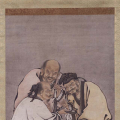Welcome home! Please contact lincoln@icrontic.com if you have any difficulty logging in or using the site. New registrations must be manually approved which may take several days. Can't log in? Try clearing your browser's cookies.
The Middle Way
 Vastmind
Memphis, TN Veteran
Vastmind
Memphis, TN Veteran
I thought this was a wonderful explanation,
from the book The Lotus Still Blooms.
Think of those you know personally who seem to have chosen the MIddle Way.
What do you see in them that you could emulate?
Balance can begin with acts as simple as turning off the computer or TV and taking
a walk in nature, reading inspirational material or meditating for 30 mins.
The Middle Way is not about never going to the movies or a club or shopping.
It is about not making these things your life, the object of your existence.
The Middle Way is also about remaining centered and
spiritually poised when life is going your way and when it is not.
The Middle Way is choosing peace in all circumstances.
It is choosing love over the need to be right.
In our world fraught with violence and conflict, it is knowing there is always a Divine way out of the
madness. The Middle Way is having the desire to find it.
Please share your thoughts about The Middle Way...
from the book The Lotus Still Blooms.
Think of those you know personally who seem to have chosen the MIddle Way.
What do you see in them that you could emulate?
Balance can begin with acts as simple as turning off the computer or TV and taking
a walk in nature, reading inspirational material or meditating for 30 mins.
The Middle Way is not about never going to the movies or a club or shopping.
It is about not making these things your life, the object of your existence.
The Middle Way is also about remaining centered and
spiritually poised when life is going your way and when it is not.
The Middle Way is choosing peace in all circumstances.
It is choosing love over the need to be right.
In our world fraught with violence and conflict, it is knowing there is always a Divine way out of the
madness. The Middle Way is having the desire to find it.
Please share your thoughts about The Middle Way...

6






Comments
I recall learning once that although animals obviously create karma, theirs is less intense/directed because they can't really put _intention_ behind their actions. Humans, on the other hand, have ... basically super powers, we have the power of intention behind our actions, and that's a key focus in Buddhism (as I understand it)
So although it's not much to add, perhaps it's just something good to keep in mind
"choosing peace in all circumstances, choosing love over the need to be right"
those are beautiful words.
The real middle way, that is, the seeking of truth, lies between sensual pleasure, which is the way of worldlings (pothujjana/puthujjana) which includes those like Joan Gattuso, and the pursuit of self mortification, for example, Jainism. This middle way of the Tathagata was gained by meditation that leads to enlightenment (sambodhi) and nirvana.
Siddhartha's own spiritual struggle went from indulging in sensual pleasures, to hardcore asceticism, both ways failing him until he found jhâna or meditation.
"Then, Aggivessana, I thought: I remember that once when my father, the Sakka, was working (in the fields), I was sitting in the cool shadow of a Jambu tree. Separated from objects which awaken desire, separated from harmful qualities I reached a (state of) joy and happiness (pîti-sukha) accompanied by contemplation and reflection which is the first jhâna/dhyâna (meditation) and remained in it for some time. Could this be, perhaps, the way (magga) to enlightenment (bodha)? After this memory, Aggivessana, I had this knowledge: this is the way to enlightenment. [Then], Aggivessana, I thought: why should I be afraid of this happiness that has nothing to do with objects which awaken desire and nothing to do with harmful qualities. [Then], Aggivessana, I thought: I am not afraid of this happiness that has nothing to do with objects which awaken desire and nothing to do with harmful qualities" (Mahasaccaka Sutta, MN 36, I p. 246).
At its most basic level it reveals that all phenomena, events, and things are empty of intrinsic or independent existence. However, there is a misapprehension that this implies that Buddhism is a form of nihilism, because it is thought that this doctrine asserts that nothing really exists, but this is not the case.
Emptiness does not imply non-existence, but as previously stated only empty of intrinsic or independent existence, and this rather implies dependent origination. It shows that dependence and interdependence is the nature of all things as things and events come into being only as a result of a multiplicity of interconnected causes and conditions, and are not self powered. Emptiness is seen as what makes the law of cause and effect, and ultimately change possible.
It is not an independent truth, or some kind of great emptiness outside of a specific phenomena. Conventionally things truly exist, but ultimately they are empty of intrinsic existence. These two truths, conventional and ultimate, are unified as a single whole as shown in the following verse from the Heart Sutra that states "Form is emptiness, emptiness is form; emptiness is not other than form, so too form is not other than emptiness". Form is not to be negated, but is rather seen as evidence of, or as an expression of emptiness.
Madhyamaka can be confusing as compared with middle way described in the Pali canon (Dhammacakkappavattana Sutta, SN 56.11). Still, essentially, the two are connected, but in a roundabout way. The Madhyamaka middle way repudiates both being and non-being so that the way is neither to be found in being nor in non-being but in their transcendence which allows the absolute or Buddha-nature to presence.
In the Pali canon it is jhâna or meditation that allows sambodhi and nirvana to presense. A true middle way has to end in sambodhi, nirvana, Buddha-nature, etc.
I should mention that the middle way does not mean mid-way or between two extremes. It is transcendence leading to ultimate reality.
http://www.accesstoinsight.org/tipitaka/sn/sn56/sn56.011.than.html
The 'extremes' teachings were/are used to emphasize that the craving can be
practiced/worked on. Maybe to reel ourselves in...at first??
The transcending finish/vision.....I Hope so!!!!!!!
I did not come up with that understanding of my own accord, but through several discourses taught by the Dalai Lama coupled with some intuitive insight. Otherwise I would just be a parrot. :-)
That sort of becomes, in the example of sex, too much is as extreme as too little. But this is not the middle way of the Buddha.
What does this ultimately mean? It does mean letting go of craving and also absolutely doing nothing, take the path as it comes along.
The only objective should be meditative jhana. Again, we as lay Buddhists have to balance our livelihood and spiritual practice, while a lot of what tha Buddha taught was for monks.
So, again it means moderation, for food, money, cravings, even meditation, cant do too much, otherwise sign up as a hermit!
Moderation = middle way.....
Or put another way. If it something isn't better than something else, it isn't worse than something else, and it isn't neutral, then what is it?
If that makes any sense. LOL
"Too much is just insufficient as too little" as a conventional truth instead of an ultimate truth?